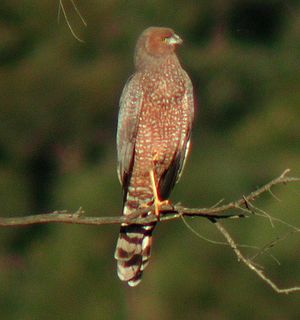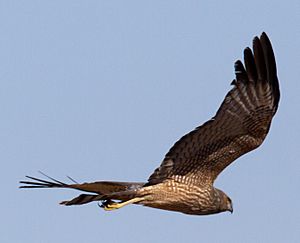Spotted harrier facts for kids
Quick facts for kids Spotted harrier |
|
|---|---|
 |
|
| Conservation status | |
| Scientific classification | |
| Genus: |
Circus
|
| Species: |
assimilis
|
 |
|
| range strongholds year-round distribution non-breeding distribution | |
The spotted harrier (Circus assimilis), sometimes called the smoke hawk, is a large bird of prey found in Australasia. It belongs to a bird family known as Accipitridae.
Contents
About the Spotted Harrier
The spotted harrier is part of the Accipitridae family. This is the biggest family in the bird group called Accipitriformes. It includes many birds of prey that hunt during the day, like hawks and eagles. There are 233 different species in this family all over the world.
What Does a Spotted Harrier Look Like?
The spotted harrier is a medium-sized, thin bird of prey. Adult females are bigger than males, growing to about 58–61 cm long. Both young and adult birds have a special "ruff" of feathers around their face. This makes their head look short and wide, a bit like an owl's. They also have long, yellow legs.
Their wings have clear black tips, and their tail has stripes. The tail is also slightly wedge-shaped.
Differences Between Males and Females
Adult male spotted harriers are smaller than females, usually 50–55 cm long. Adult birds have blue-grey feathers on their upper bodies. Their face and underparts are a chestnut color with many white spots.
Young Harriers
Young harriers in their first year are mostly dark brown and light brown on top. Their undersides are pale brown with brown streaks across their chest and stomach. In their second year, they start to look more like adults. They get white streaks on their undersides instead of the clear spots seen on older birds.
Where Do Spotted Harriers Live?
Spotted harriers are originally from Australia and Indonesia. Sometimes, they are also seen in Timor-Leste. They live across a very large area, covering more than 20,000 square kilometers.
You can find spotted harriers almost everywhere on mainland Australia. However, they usually avoid thick forests or woodlands near the coast. They are also rarely seen in Tasmania. In New South Wales (NSW), they are spread out across the state.
Their Favorite Places
The spotted harrier is a land bird. It prefers open grasslands and open woodlands, including areas with acacia trees or mallee shrubs. They also live in woodlands near rivers, grasslands, and shrublands.
They are most often found in native grasslands. But you might also see them hunting for food in farm areas or wetlands inland.
What Do Spotted Harriers Eat?
The spotted harrier is a meat-eating bird of prey. It mostly eats small animals that live on the ground. This includes mammals like bandicoots, bettongs, and rodents. They also eat small birds, reptiles, and sometimes large insects.
They used to eat a lot of rabbits. But a disease called rabbit calicivirus caused rabbit numbers to drop a lot. Because of this, spotted harriers now rely more on native animals for food. Many of the native mammals they used to eat are now gone from inland NSW. Also, some of their remaining prey, like grassland birds, are in danger because of grazing. These birds need ground cover, which can be lost when habitats are damaged.
When hunting, the spotted harrier flies high in the sky with its wings held up.
Reproduction and Life Cycle
Spotted harriers build their nests out of sticks in trees. They usually lay eggs in spring, but sometimes in autumn. A female will lay 2 to 4 eggs at a time. The eggs hatch after about 33 days. The young birds stay in the nest for several months after hatching. A spotted harrier's "generation length" (how long it takes for a new generation to grow up) is thought to be about 10 years.
Conservation Status
The spotted harrier is listed as a species of "Least Concern" by the International Union for the Conservation of Nature. This is because it lives across a very large area, and its population is big and stable.
A study in NSW from 1977-81 looked at bird populations. Spotted harriers were seen quite often. Breeding was recorded in 14 areas. A similar study in 1998-2002 found that spotted harrier numbers had gone down in NSW. Breeding was only seen in 6 areas. This suggests a big drop in numbers in NSW over 30 years.
However, this study only covered a small part of the harrier's total range. So, it might not show the full picture for the whole species. Also, many threats in NSW are not as common in other areas. A study across the harrier's entire range would give a more accurate idea of its population. Still, this study helps NSW create plans to manage the birds in that state.
Threats to Spotted Harriers
The biggest threats to spotted harriers are the clearing and damage of their habitats. This includes places where they hunt and build nests. These threats also affect the animals they eat, making it harder for the harriers to find food.
Clearing land and grazing by livestock are major threats to their nesting sites. They are also at risk from secondary poisoning. This happens when they eat rodents or rabbits that have been poisoned by chemicals like rodenticides or pindone.
Clearing native plants is a major threat in NSW. This has affected important areas in western NSW where many harriers used to breed. Since the 1980s, 40-84% of these areas have been cleared. Also, 85-91% of these areas have been affected by grazing. Many of these regions are also under stress from human activities. More western NSW regions are also heavily grazed and show signs of environmental stress.
See also
 In Spanish: Aguilucho moteado para niños
In Spanish: Aguilucho moteado para niños



